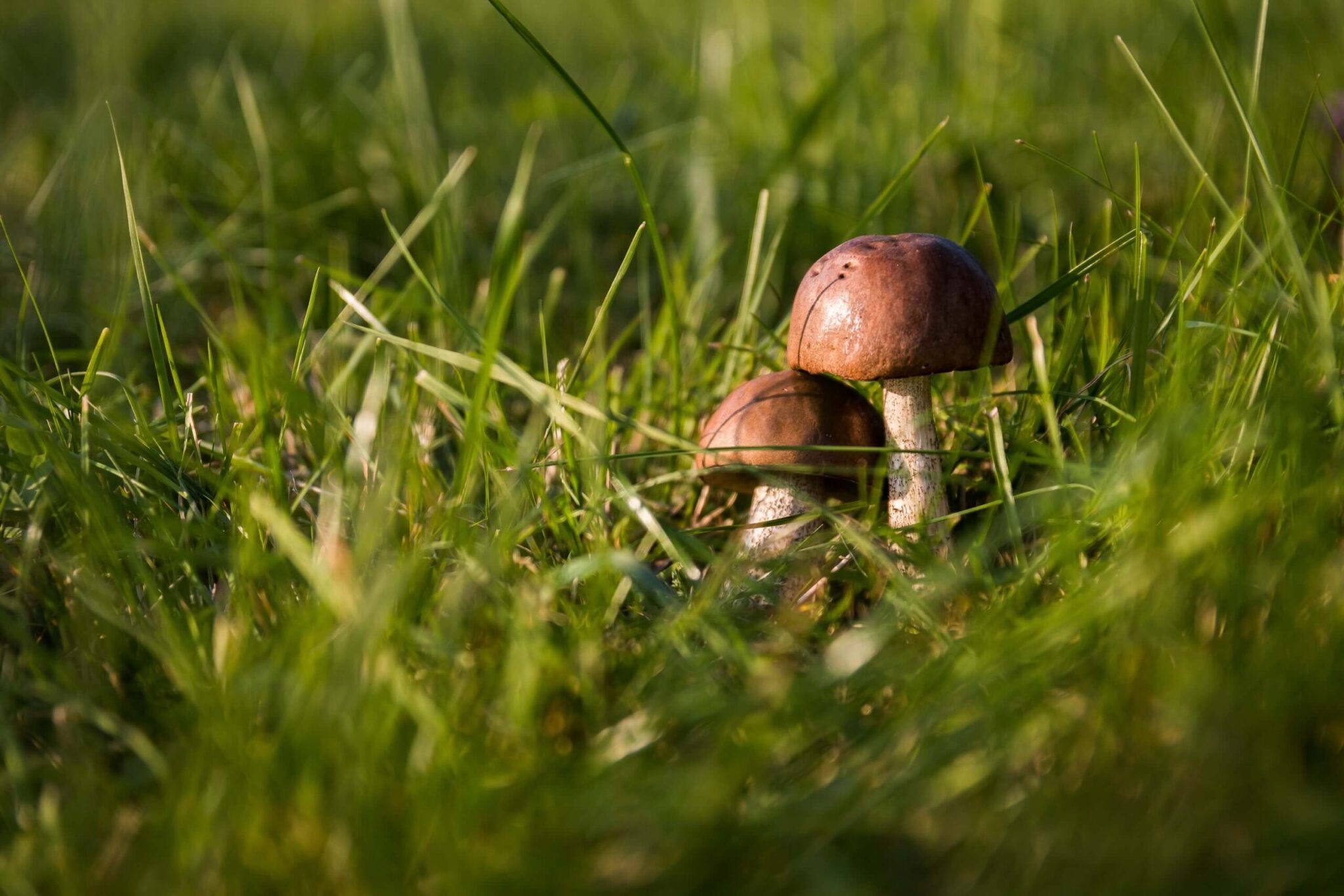How to Get Rid of Mushrooms
Though sauteed mushrooms might be delicious on a steak or in a salad, most homeowners don’t love the look of mushrooms growing on their property. While a few mushrooms can be a sign that your soil is healthy and supporting a host of good fungi that keep your lawn safe, too many mushrooms can quickly take over your lawn and begin killing your grass.
Our guide to removing mushrooms will help you understand these common plants, decide if you need to remove them from your lawn, and create a plan to get your lawn back on track.

What are Mushrooms?
Mushrooms are the reproductive structure used by some types of fungi to spread spores. A mushroom can spread its spores when it is picked, carried by wind, or broken apart by an animal. When a spore lands on a suitable surface (like your lawn) it will grow a large network of roots that can eventually turn into a new mushroom. Though the mushroom can be broken down or cut away, these networks of roots may persist in your soil, which can make getting rid of mushrooms a long battle. Thankfully, most mushrooms don’t need to be removed for the sake of your lawn’s health.
Mushrooms play an important role in the ecosystem of your lawn. Mushrooms are responsible for breaking down organic matter and reintroducing it to your soil. This is a mutually beneficial relationship for both the mushroom and your grass—your grass gets to take advantage of broken-down organic waste created by the mushroom, while the mushroom gets the oxygen and nutrients it needs to create additional spores and survive. Enzymes released by mushrooms have also been found to help grass survive periods of drought and stress as well.
Are the Mushrooms in My Lawn Harming My Property?
First, the good news—a few mushrooms likely won’t cause serious issues in your lawn. In most cases, mushrooms are a sign that your soil is healthy and that your lawn has a thriving culture of beneficial fungi and bacteria living below the crust of your soil. Though you might not love the look of a mushroom, chances are that one or two of these plants won’t actively harm your grass.
If you have too many mushrooms growing in your yard, the fungi can start to overcrowd your grass roots. This forces your grass to begin competing with the mushrooms for nutrients, oxygen, water and other resources that your lawn needs to stay lush, green, and healthy. A large mushroom may develop a network of branching filaments called a “hyphae” to maximize its nutrient intake. These hyphae can often choke out your grass’s roots, causing sections of your lawn to die. If you have more mushrooms than your neighbor and you’re seeing brown patches of grass on your lawn, chances are that the mushrooms are the culprit.
Some homeowners worry that the mushrooms that are growing in their lawn could be poisonous and potentially harm or even kill a child or animal. While it’s exceedingly rare to find a poisonous mushroom growing on a residential lawn, it is still possible. We strongly advise against consuming any type of fungi growing on your lawn, as it can be difficult to differentiate between edible and nonedible mushrooms. Pick and dispose of mushrooms growing sporadically in your lawn to keep children and pets safe, and always use gloves when handling mushrooms that you aren’t familiar with. While this won’t remove the mushroom forever, it’s a quick and convenient way to keep your property secure.
How to Get Rid of Mushrooms in Your Lawn
If you have too many mushrooms on your property or you really can’t stand the look of this common fungus, you have a few options when it comes to removing them from your lawn. Let’s explore a few methods you may consider using to get rid of mushrooms on your property.
Control water on your lawn
Fungi require a cool, damp environment to flourish. Keeping your lawn as dry as possible is one of the first steps you’ll need to take in order to make your lawn less hospitable to mushrooms. Cut down on your watering schedule, and water your lawn only when your grass needs it. Avoid using sprinkler systems to water your lawn if possible, as these systems tend to distribute more water to your lawn.
We recommend watering your lawn deeply and infrequently if you’re dealing with a mushroom problem. Water your lawn early in the morning whenever you can—this method allows your lawn to soak up the water it needs before drying off in the afternoon. Avoid watering your lawn at night or in the early evenings, as this can create the ideal environment for mushrooms to grow in your lawn.
Reassess your mowing schedule
Shorter grass tends to dry faster than longer grass because water droplets can easily evaporate as soon as the sun comes out. If you’re dealing with more mushrooms this year, you may want to mow your lawn more often or set your mower to a lower setting when you cut your grass.
One important note—be sure that you remove mushrooms currently growing in your lawn before you mow. This will help protect your lawnmower and will ensure that your mower doesn’t spread spores around the lawn while mowing, which can make your lawn’s mushroom problem significantly worse.
Remove decaying wood from your property
If you’ve ever had a tree stump or piece of wood on your property, you may have noticed a few mushrooms sprouting up around it. Decaying wood material provides spores with plenty of organic material they can use to create and support colonies of mushrooms.
You can reduce mushroom populations in your lawn by removing any type of decaying wood from your property. This includes stumps, fallen trees, and old sandboxes or playsets made of wood. Always contact a professional lawn service provider to remove trees, branches, or stumps from your property—never attempt to fell a tree on your own.
Aerate your soil
When you aerate your soil, you improve airflow from the atmosphere to your grass. This can help your lawn dry faster while also ensuring that your grass’s roots have access to a regular flow of nutrients and water. Aerating your soil can also break up hyphae and thatch, which can both contribute to lawn diseases and problems with dying grass.
Most experts recommend that you aerate your lawn once per year in order to keep your grass lush and healthy. You may need to aerate your lawn more often if you have compacted soil. Consulting with a local team of lawn care professionals can help you create an ideal aeration schedule for your property.
Remove animal waste from your lawn
If you have a pet, be sure to frequently clean up after them if they use your lawn to go to the bathroom. Animal waste contains organic materials similar to those found in decaying wood, which means that leaving waste on your lawn can cause more mushrooms to pop up on your property.
Make cleaning up after your pet a part of your daily chores at the end of the day. If you have a dog, you might want to invest in a waste station and place it away from any decaying wood or patches of mushrooms on your property.
Apply a nitrogen-based fertilizer
Using a nitrogen-rich fertilizer on your lawn speeds up the removal process of organic material, which takes away the fungi’s source of food. Nitrogen-enriched fertilizers can greatly shorten the lifespan of any mushrooms on your property and even stop them from coming back almost completely if used consistently year after year. In addition to killing off mushrooms, these fertilizers are also great for your lawn and can provide you with healthier grass throughout the year.
If you do decide to use a nitrogen-enriched fertilizer to correct mushroom outbreaks, you’ll need to be sure that you’re removing all other types of organic material that fungi can use to feed on as well. Start by relocating all types of decaying wood from your lawn and be sure that you remove any roots left after you dig up a shrub, bush, or tree.
Use fungicides sparingly
If you want to quickly remove mushrooms in your lawn, your first thought might be to head down to your local hardware store and pick up a fungicide product. While mushrooms are fungi, they cannot effectively be removed with most types of fungicides because these products are designed to kill shallow fungi like moss and mold. Though the fungicide might kill off the mushroom, they typically cannot penetrate your soil deep enough to kill off the hyphae that constitute the majority of the fungus. This means that the mushroom will likely return. These types of products also kill off the beneficial microbes in your soil, which can lead to long-term damage to your lawn and your grass’s health.
Fungicides can work by containing a mushroom’s spores and preventing them from spreading throughout your lawn. If you’re very worried about containing a mushroom and preventing it from generating more fungi throughout your lawn, a fungicide can provide a quick fix. Be sure to use the fungicide only where mushrooms are growing and apply the product as sparingly as possible.
The Path to Lush, Green Grass
The bottom line? If mushrooms aren’t actively harming your lawn, it’s best to let them be. Mushrooms provide your grass with natural, rich organic material and can help enhance the health of your grass. Most mushrooms will go away on their own in as little as a few days after they sprout up.
Instead of working to fight off mushrooms in your lawn, it’s better to take your time and create a comprehensive lawn care plan that improves the condition of your soil. TruGreen is a local lawn care service provider that specializes in providing homeowners with the personalized service plan they need to bring out the best in their lawn. To learn more about TruGreen or to claim your free quote, give us a call today at 877-349-9084.







